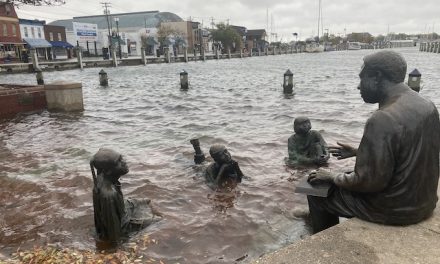By Nick DiMarco
Nick@MarylandReporter.com
Maryland’s residential neighborhoods will begin to see some drastically different environmental features, as developers begin working under new environmental guidelines being put in place by local governments this year.
Developers are looking at ways to implement facets of environmental design, as required under stricter rules for the management of stormwater finalized during the 2010 legislative session.
The goal is to slow the rate at which rainwater flows from streets and driveways. When it rains, water collects pollutants and begins to stream its way into the Chesapeake Bay through storm drains and other waterways. But when the water can pass through soil and other natural filters, the damage is reduced.
So what does the new stormwater management look like?
Imagine streets without sidewalk curbs, where water runoff courses its way into directly into roadside soil. Picture 55-gallon barrels, collecting rain as it drips from rooftops. Envision vegetation flourishing where few plants grew before.
“The idea with environmental site design is to sort of intercept flow at a variety of locations using less structural approaches. With proper design, this could really enhance communities,” said Chris Streb, ecological engineer for Biohabitats Inc.
Streb’s group is a “high-end environmental firm” that works with land developers through the planning process of building sustainable communities. They are currently working on a project in Columbia, featuring environmental site design that will apply to 5,000 homes.
In the past, stormwater management consisted mostly of digging ponds at low points in communities, in order to collect runoff.
A fixture in Ellicott City resident Joan Stricker’s backyard is a man-made wetland, serving as a stormwater management facility. She says her children enjoyed playing in it when they were little.
But today, the feeder pools that drain into the moderately sized pond no longer work and the area serves as worry for some parents in the area.
“Oh yeah, some of the moms in the neighborhood won’t let their kids go near it because of ticks, snakes and mosquitos,” she said.
The new regulations decentralize the practice, spreading out devices and using new techniques throughout residential and commercial properties to ease the flow of water.
“What I think you’re going to see is a much more distributed practice. You could have streetscapes that instead of having a storm drain inlet, you may have a curb cut and behind that curb cut you’ll have a bio-retention garden,” Streb said. “Every single street tree you have can be a stormwater treatment practice. You could have a curbless street section in which the water is streaming off into side soils.”
The use of rain gardens and porous pavement to soak water into soil will become more prevalent as well. Rain barrels collect runoff from a building’s roof, and store the water for later uses like watering a garden or lawn.
While developers are being forced to implement these designs, there is still a little hesitation to the change, according to Streb.
“Developers have these old ideas of convention. They have a model that they’ve made money from so they know how to build and they know how to make money the way they’ve done it before,” said Streb.
He conceded some practices may cost more, but said others could cut costs. Street curbs are expensive, he said as an example.
Even real estate agents have come around to the changes. Steve Meszaros, president of the Maryland Association of Realtors, said his organization in the past has “vehemently” opposed all legislation pertaining to stormwater management.
Still, he acknowledged that some changes were needed.
“You have to be conscious of the environment. I don’t think there’s any question about that. You can’t just let stormwater runoff go any which way and cause problems with mud and whatever else, as some developers were doing many years ago,” he said.
He noted that realtors “don’t have a great dog in this fight” when it comes to selling properties.
“The more regulations and the more restrictions you have on any property it certainly affects the ability to transfer that property, but I wouldn’t say it has a huge impact on marketing or transferring the property because the property is involved in stormwater management.”






Recent Comments